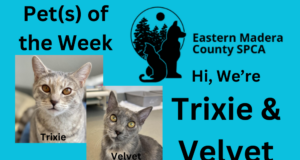First – a feral cat is one that CANNOT be handled. If you can touch, pet or cuddle the cat, they are not feral.
The SPCA has funds for spaying or neutering feral cats. This is to help reduce the population of feral cats in neighborhoods & create a healthier cat colony.
If you have feral cats (we have 10 or more in our neighborhood) call the SPCA at 559-683-1266 and ask for a “number” for the feral cat program.A volunteer from the local SPCA will call you back in a few days and tell you what the definition of a feral cat is and then they will issue you a number. Write it down.
Second, trap the cat. Traps can be rented at the veterinary clinics and at Sierra Nursery. A deposit of between $30 & $50 is required. They are a fairly expensive item to purchase & the deposit is returned to you when you return the trap.
The best item to use to trap a cat is a can of cat food. I like cheap and stinky. The traps are easy to use and you can ask for instruction from the place you rent it.
Will you catch a skunk or a raccoon? Sure is a possibility. My neighbor caught a skunk – I covered the trap with a plastic tarp to protect me from spray & then opened the trap. The skunk did not want to come out while I was there (which was just fine with me) I walked away then he/she slipped out and later I recovered the trap. I found this article to be very helpful. http://sonic.net/~pauline/release.html
For the safety of the cat, you should capture the cat the day before you are taking them to the vet. DO NOT capture a cat on Friday and leave them in the cage until Monday, Tuesday, or whichever date you are planning to take them to the vet – this is cruel. Also – only ONE cat per trap.
Third, call one of the three local veterinarians. See days listed below with vet contact information. Oakhurst Vet Hospital, Hoof and Paw Vet Hospital and Coarsegold Vet Hospital all provide, and are paid for, spay or neuter surgery of feral cats under the funding. They will ask you for your feral number. They will also tell you which days they provide this service and any other information important to their services.
Coarsegold Veterinary Hospital – 559-683-4991: Provide services Monday, Wednesday, and Friday. They also require that the cat receive vaccinations – an out of pocket expense to you $75-80 per cat. The SPCA states that vaccinations are not necessary for feral cats. There are valid arguments for and against this; just be aware that this will be an out of pocket expense.
Hoof and Paw Veterinary Hospital – 559-683-3313: Provide services for males and females cats on different days: Males on Monday and Friday; females on Monday, Wednesday and Friday.
Oakhurst Veterinary Hospital – 559-683-2135: Provide services on Tuesday and Thursday.
Neither Hoof and Paw nor Oakhurst Veterinary stated the need for vaccinations or that there were any additional out of pocket costs to you. However – as policies at vet clinics can change – please call before arriving with your trapped cat in hand.
Now what? The feral cat has been sterilized and now needs to be picked up by you and returned to the area where they were captured. They do not need to be kept in seclusion, or monitored – they can be immediately released. They will no longer produce or be responsible for producing litters of unwanted cats.
You will note that the cat’s ear has been “tipped”. Ear-tipping is the humane surgical removal of 1/4 tip of the left ear and a widely accepted means of marking a feral cat who has been sterilized.
The procedure is performed during the surgery, is completely safe and rarely requires special aftercare. Ear-tipping prevents an already spayed or neutered cat the stress of re-trapping and more importantly, an unnecessary surgery.
One last step – follow the same procedures outlined above to capture and sterilize the balance of the feral cats in your neighborhood. It is important to have all feral cats spayed/neutered, because it is a 100-percent effective way to prevent unwanted kittens.
Additionally it is believed that reducing the number of feral cats in the colony will allow them naturally to have more space, shelter and food, and fewer risks of disease.
Now – pat yourself heartily on the back for having done a great thing for your neighborhood and the cats.
Sincere thanks to Sharon at EMCSPCA for e-mailing me this week and clarifying the position of their organization on vaccinations for feral cats:
Pamela Rank is the Marketing and Social Media Volunteer for Kellen Rescue




Friends of Madera Animal Shelter also has an excellent feral program! Please, check it out at http://www.gofmas.com/programs-feral-cats.html